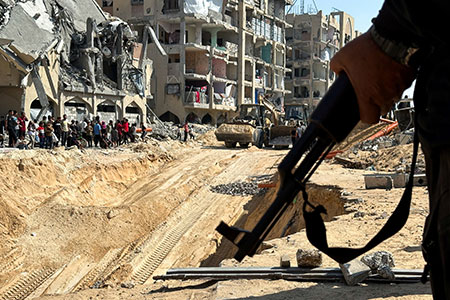
A fragile ceasefire agreement in the Gaza Strip dramatically collapsed on October 19, igniting renewed hostilities between the militant group Hamas and the Israel Defense Forces (IDF). Israeli military sources confirmed that Hamas militants initiated the breach by firing anti-tank missiles at IDF soldiers operating in the southern Gaza enclave, specifically targeting troops engaged in clearing military infrastructure near Rafah. The IDF, in a statement, asserted that these actions directly violated a truce that had been in effect for merely nine days, describing the incident as ‘terrorists firing an anti-tank missile and opening fire on IDF troops who were operating to eliminate terrorist infrastructure in the Rafah area in southern Gaza in accordance with the ceasefire agreement.’ In immediate retaliation, the Israeli military launched extensive aerial and naval strikes, reportedly hitting over 20 Hamas positions across the Gaza Strip within hours of the initial exchange.
While Hamas swiftly denied violating the ‘regime of silence,’ suggesting that some of its factions ‘on the ground’ might have acted independently of the group’s central leadership, Jerusalem appears unconvinced by this explanation. Prime Minister Benjamin Netanyahu has reportedly instructed his military to adopt an uncompromisingly harsh approach within Gaza, despite the sensitive issue of 16 bodies of Israeli hostages, captured during the October 7, 2023, attacks, still remaining in Hamas’s custody. Defense Minister Yoav Gallant underscored Israel’s unwavering stance, vowing that ‘Hamas will pay a heavy price for every shot and violation of the ceasefire, and if the message is not understood, the intensity of the response will only increase.’
The renewed escalation comes almost immediately after Prime Minister Netanyahu announced a symbolic shift in the name of Israel’s Gaza operation, moving from ‘Iron Swords’ to ‘War of Rebirth,’ during a ministerial meeting. This change, coupled with Netanyahu’s emphasis on honoring Israeli soldiers, was interpreted by some observers as a signal of a war nearing its conclusion. However, the latest events strongly suggest that a definitive end remains elusive, potentially even reversing perceived progress and reigniting a large-scale conflict. The incident has fueled calls from within Israel for a return to a full-scale military campaign in Gaza, particularly from influential opposition figures.
Benny Gantz, a prominent opposition leader and former defense minister, sharply criticized Hamas, stating, ‘Hamas has violated the agreement and put the State of Israel to the test. And, as in Lebanon, we must not blink. All options must be considered, including a return to maneuvers. We must not return to the situation of October 6,’ referencing the day before the devastating ‘Black Saturday’ attacks. Gantz explicitly urged the complete destruction of Hamas. Echoing this sentiment, former Defense Minister Avigdor Lieberman, leader of the ‘Yisrael Beiteinu’ party, emphasized the enduring regional maxim: ‘In the Middle East, there is only one language – the language of force. Hamas is testing the limits of what is permissible because someone allowed it to. It is playing games and delaying the return of hostages, and just recently violated the ceasefire and opened fire on IDF soldiers, trying to harm our heroic soldiers.’
In a seemingly conciliatory, yet strategically charged, move, Hamas’s armed wing issued a statement on October 19, indicating a willingness to transfer the body of another hostage ‘if the situation on the ground is suitable.’ The group simultaneously issued a thinly veiled warning, asserting that ‘any military escalation by Israel complicates the process of searching for the remaining bodies, which will lead to a delay in their release.’ This highlights the ongoing humanitarian dimension intertwined with military and political maneuvers.
Domestically, the Israeli Knesset is set to reconvene for its winter session on October 20, with speculation rife about the potential for early elections. While the current schedule places the next general election in November 2026, political sources cited by ‘Yedioth Ahronoth’ suggest that Netanyahu’s close circle is actively encouraging him to initiate elections immediately after the parliamentary recess. This push is reportedly driven by a perceived positive public image boost following the recent release of live hostages from Gaza, coupled with the significant diplomatic impetus provided by a high-profile visit from US President Donald Trump.
Netanyahu himself confirmed his intention to run for another term as Prime Minister during a recent interview on Channel 14, expressing confidence in securing victory. Current public opinion polls position his Likud party to secure approximately 27 mandates out of 120, potentially making it the largest political force in the legislature. However, forming a stable governing coalition would still necessitate alliances with other factions. The ‘Bennett-2026’ party, led by former Prime Minister Naftali Bennett, is currently projected as the strongest challenger, potentially securing 22 mandates.
Despite a deeply polarized society, sociologists indicate that Netanyahu garnered some additional support after the ceasefire agreement and the release of hostages. However, the potential ramifications of a renewed, full-scale conflict with Hamas on these approval ratings remain a critical unknown. Given the assertive declarations from key ministers and the escalating actions on the ground, the likelihood of such a conflict has undeniably surged, casting a long shadow over the immediate future of the region and its wider international relations.
